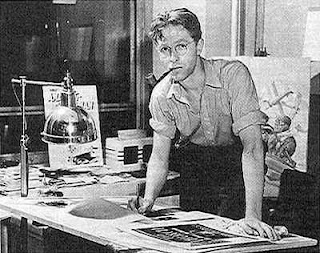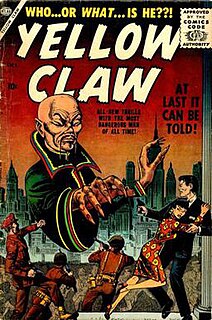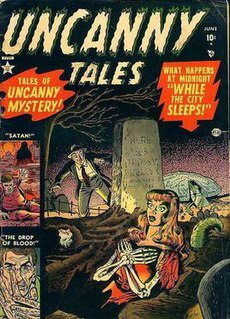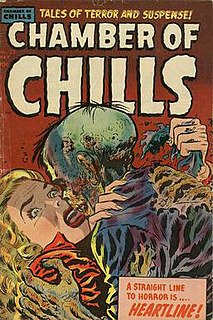
Tales of Suspense is the name of an American comic book anthology series and two one-shot comics published by Marvel Comics. The first, which ran from 1959 to 1968, began as a science-fiction anthology that served as a showcase for such artists as Jack Kirby, Steve Ditko, and Don Heck, then featured superheroes Captain America and Iron Man during the Silver Age of Comic Books before changing its title to Captain America with issue #100. Its sister title was Tales to Astonish. Following the launch of Marvel Legacy in 2017, Tales of Suspense was once again resurrected at issue #100, featuring the Winter Soldier and Hawkeye in a story called "The Red Ledger".
Strange Tales is a Marvel Comics anthology series. The title was revived in different forms on multiple occasions. Doctor Strange and Nick Fury, Agent of S.H.I.E.L.D. made their debuts in Strange Tales. It was a showcase for the science fiction/suspense stories of artists Jack Kirby and Steve Ditko, and for the groundbreaking work of writer-artist Jim Steranko. Two previous, unrelated magazines also bore that title.

John V. Romita is an American comic book artist best known for his work on Marvel Comics' The Amazing Spider-Man and for co-creating characters including the Punisher and Wolverine. He was inducted into the Will Eisner Comic Book Hall of Fame in 2002. Romita is the father of John Romita Jr., also a comic book artist and husband of Virginia Romita, for many years Marvel's traffic manager.

William Blake Everett was an American comic book writer-artist best known for creating Namor the Sub-Mariner as well as co-creating Zombie and Daredevil with writer Stan Lee for Marvel Comics. He was allegedly a descendant of the childless poet William Blake and of Richard Everett, founder of Dedham, Massachusetts.

Donald L. Heck was an American comics artist best known for co-creating the Marvel Comics characters Iron Man, the Wasp, Black Widow, Hawkeye and Wonder Man and for his long run penciling the Marvel superhero-team series The Avengers during the 1960s Silver Age of comic books.
Carl Burgos was an American comic book and advertising artist best known for creating the original Human Torch in Marvel Comics #1, during the period historians and fans call the Golden Age of comic books.

Joseph Maneely was an American comic book artist best known for his work at Marvel Comics' 1950s predecessor, Atlas Comics, where he co-created the Marvel characters the Black Knight, the Ringo Kid, the Yellow Claw, and Jimmy Woo.

The Yellow Claw is a supervillain appearing in American comic books published by Marvel Comics. Created by writer Al Feldstein and artist Joe Maneely, the character first appeared in Yellow Claw #1, published by Atlas Comics, the 1950s predecessor of Marvel.

Atlas Comics is the 1950s comic-book publishing label that evolved into Marvel Comics. Magazine and paperback novel publisher Martin Goodman, whose business strategy involved having a multitude of corporate entities, used Atlas as the umbrella name for his comic-book division during this time. Atlas evolved out of Goodman's 1940s comic-book division, Timely Comics, and was located on the 14th floor of the Empire State Building. This company is distinct from the 1970s comic-book company, also founded by Goodman, that is known as Atlas/Seaboard Comics.

The Ringo Kid is a fictional Western hero in the Marvel Comics' universe, whose comic book series was originally released by the company's 1950s predecessor, Atlas Comics. A lesser-known character than the company's Kid Colt, Rawhide Kid, or Two-Gun Kid, he also appeared in a reprint series in the 1970s.

Tales of the Zombie was an American black-and-white horror comics magazine published by Magazine Management, a corporate sibling of Marvel Comics. The series ran 10 issues and one Super Annual from 1973 to 1975, many featuring stories of the Zombie by writer Steve Gerber and artist Pablo Marcos.

The Zombie is a fictional supernatural character appearing in American comic books published by Marvel Comics. The character was created by writer Stan Lee and artist Bill Everett for the standalone story "Zombie" in the horror-anthology comic book Menace #5, which was published by Atlas Comics, a forerunner to Marvel. The character later became well known for starring in the black-and-white horror-comic magazine series Tales of the Zombie (1973–1975), usually in stories by Steve Gerber and Pablo Marcos.
Marvel Tales is the title of three American comic-book series published by Marvel Comics, the first of them from the company's 1950s predecessor, Atlas Comics.

World of Fantasy was a science fiction/fantasy comic book anthology series published by Marvel Comics' 1950s predecessor company, Atlas Comics. Lasting from 1956 to 1959, it included the work of several notable comics artists, including industry legends Jack Kirby, Steve Ditko, and Bill Everett.

Carroll O. Wessler, better known as Carl Wessler, was an American animator of the 1930s and a comic book writer from the 1940s though the 1980s for such companies as DC Comics, EC Comics, Marvel Comics, and Warren Publishing.

The Western Kid is a fictional Old West character appearing in American comic books published by Marvel Comics. The character was the star of Western feature published by Marvel's 1950s precursor, Atlas Comics.

Uncanny Tales is the name of two American science-fiction / horror comic-book series, published in the 1950s and the 1970s. The first volume was by Atlas Comics, the 1950s precursor of Marvel Comics, and the second volume by Marvel. It is also the title of a British comics digest.

Chamber of Chills is the name of two anthology horror comic books, one published by Harvey Publications in the early 1950s, the other by Marvel Comics in the 1970s.

Horror comics are comic books, graphic novels, black-and-white comics magazines, and manga e.g. focusing on horror fiction. In the US market, horror comic books reached a peak in the late 1940s through the mid-1950s, when concern over content and the imposition of the self-censorship Comics Code Authority contributed to the demise of many titles and the toning down of others. Black-and-white horror-comics magazines, which did not fall under the Code, flourished from the mid-1960s through the early 1980s from a variety of publishers. Mainstream American color comic books experienced a horror resurgence in the 1970s, following a loosening of the Code. While the genre has had greater and lesser periods of popularity, it occupies a firm niche in comics as of the 2010s.

Gunsmoke Western was an American comic book series published initially by Atlas Comics, the 1950s forerunner of Marvel Comics, and then into the 1960s by Marvel. A Western anthology that ran 46 issues, it featured early stories of the Marvel Old West heroes Kid Colt and the Two-Gun Kid, and work by such artists as Jack Kirby, John Severin, Joe Maneely, Doug Wildey, and many others.
















